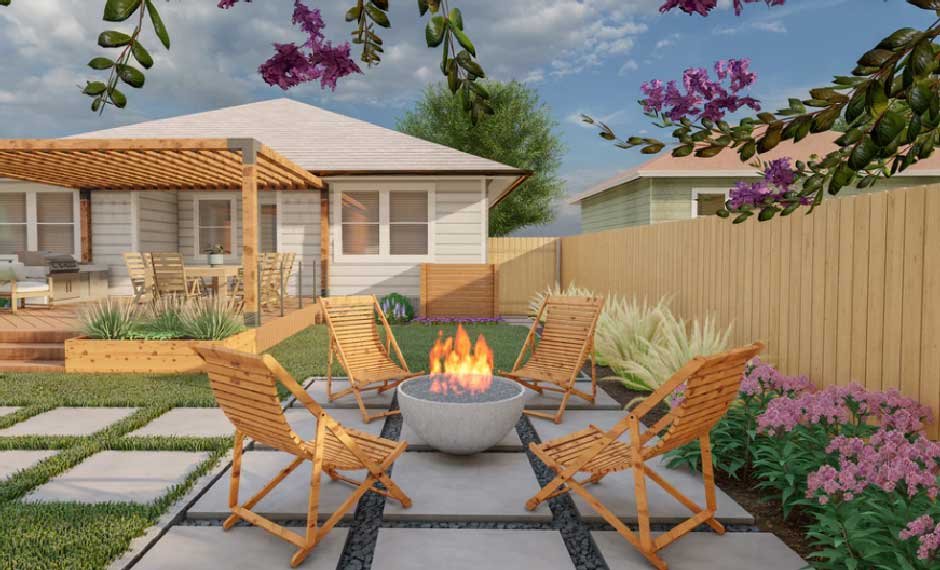Your backyard is meant to be a fun retreat for the entire family. Landscaping, furniture, and creativity combine to create a space that tickles everyone’s fancy. With so many options before you, how can you decide on what designs and decorations to use on your outdoor space? The smartest strategy is to involve your family in the decision, advises Gulf Income Property Management company. When everyone’s input is taken into account, you can create a beautiful backyard that you have all worked hard to build. If you want a yard that really puts your home on the map, you may want to get a little inventive.
Themed Gardens
Landscaping can make or break an outdoor space. If you’ve got drab landscaping, your family won’t find much incentive to relax there. A great way to involve your kids in yard planning is to garden with them. Your family can brainstorm the types of gardens and landscaping you’d want to see in the yard, from Japanese zen gardens to a miniature farm. Secret gardens can be exciting for kids to help build and play in. A butterfly garden can help your family get in touch with nature, especially if you cater to birds, bees, and other pollinating creatures. Your kids can help you choose and plant flowers, trees, and shrubs that fit the theme and style of the gardens you choose. Decorations and seating add function and style, too.
Poolside Paradise
Not much excites children more than a pool, especially one built in their backyard. Pools are expensive, but they add timeless fun and home value. You can create a backyard paradise with a surrounding patio and entertainment area. Throw in a few lounge chairs and a fire pit, and you’re the envy of the neighborhood. You and your kids can have fun decorating the surrounding pool space with appropriate landscaping, lighting, and decor. If you really want to go all out, a custom deck builder can tailor the space exactly to your family’s visions. Colorful pool lights, outdoor kitchens, and custom features like waterfalls can really enhance the space and make it your own. Be sure to appropriately budget and consider the maintenance cost and work a pool might add to your lives, however. A cost-friendly alternative could be a temporary or above-ground pool, too.
Tranquil Treehouse
A treehouse is a backyard feature that most kids can only dream of. They’re playhouses situated on or near trees for an immersive, secretive outdoor time. When properly constructed, they’re safe and make a yard look fun and unique. It can be tough to build a treehouse on your own, though. There are a ton of prefabricated playsets you can place near trees, but you may need to get your hands dirty or hire a contractor to build a tailor-made genuine treehouse. Your kids will have a blast choosing treehouse features, and when the construction is complete, you can paint and decorate the house as you see fit. Some solar-powered string lights can make the space really pop, especially at night.
Playground Patio
If a treehouse sounds too intimidating, you can swap it for a fun playset instead. As a bonus, a playground can include a miniature shed or playhouse to mimic the excitement of the treehouse without the major construction project that comes with it. Involve your kids in the type of playset they’d like—swings, slides, and rock walls are all popular features. You can browse prefabricated sets together for a better sense of what they’d like, too. Like the treehouse, you can decorate and plant gardens around the play area with your kids for a family-friendly activity.
Mini-Golf Manor
If you’re more of a sports-loving family, you can’t go wrong with building a charming miniature golf course in your yard. Vibrant green grass, towering windmills, and strategic landscaping can create the whimsical backyard of your dreams. You can incorporate other sports as well, such as basketball courts, baseball fields, and fitness areas to promote exercise and outdoor fun. Your kids can have a blast designing the perfect sports fields complete with thematic and immersive landscaping.
Pet Park
Your dog is part of the family, too. When was the last time you treated your dog to a fun run through a park or on an agility course? Depending on your dog’s breed, they can find a lot of value in a dog-centric backyard. Agility courses, fetch fields, grooming stations, swimming pools, and sandbox digsites can provide hours of entertainment for your family while your dog has the time of their life! Your kids can learn how to teach the dog tricks, agility, frisbee, Fast CAT, dock diving, or other sports in the comfort and safety of your backyard. You can decorate the space with pet-friendly landscaping, and even paint the fence with fun colors or pawprint shapes—bonus points if you use your dog’s pawprints!
Conclusion
Transforming your backyard can be a family-friendly activity that benefits everyone. The best way to choose the right direction your yard should go is to set goals for your outdoor space. You don’t have to convert the entire yard for one purpose; you can incorporate multiple styles, amenities, and purposes. For major changes, be sure to budget and plan accordingly. If your yard is smaller, you may be more limited, but you can create the backyard of your dreams with just a bit of creativity and innovation.






Leave a Reply